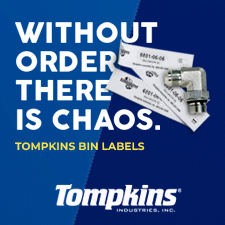The two great myths of distribution selling
by Scott Benfield

Any good chili maker knows that if you don't stir the pot now and then, you won't like the end result. So it goes with the pot of knowledge vs. practice, and experience vs. perspective. If we lose the ability to stir our own complacency and invigorate our thinking, the good stuff may just sink to the bottom and burn.
Distributors are at point in time when they need to stir the pot. They need to challenge the sales culture, examine a few of its practices and ask themselves some tough questions. There are more than enough signals from customers that the sales game needs to change. The wholesale firm may just be on the third generation of driving an old model of business, and the unmixed chili we're serving up is weak, our customers are tired of it and we're not living off of it as well as we could.
Great sales myth No. 1: Customers want to be sold
Sellers have a trump card defense when it comes to justifying their existence. It's called "relationship." Just about anytime I've tried to challenge why wholesalers put the most expensive part of the marketing mix (personal sales) behind commodity products, I am trumped by "relationship." It makes no difference that there is almost no tangible measurement to the "R" word; it only has to be said and sellers automatically assume the King of the Hill position that they have held for the last 75 or so years. Granted, it takes familiarity with the customer and the element of trust to establish key account relationships (I used the R word!). However, many customers may be rethinking what they get from distribution sellers and are looking for less invasive, more convenient ways to transact business and a little less "R."
My reasoning for this relies on two areas of study and their implications. First, a recent survey of industrial MRO buyers found that 48 percent answered "no" when asked, "Do you want distributor salespeople calling on you?" Mind you, there will always be some customers who say "no" to a sales call. But if the average cost of an outside sales force is 4 percent of sales, and 48 percent are not wanted, the math (48 percent of 4 percent) frees up 1.92 percent. This could almost double the earnings before interest and tax (EBIT) of the average distributor.
Of course the math is never quite so easy. Some customers actually want sellers and some transactions need to be manned on the outside. For those in a quandary of just where, how, and why manned selling needs to occur, I'll point you to an interesting book: Rethinking the Sales Force. The authors, Neil Rackham and John De Vincentis, propose three basic models of selling including transactional, consultative and enterprise. For distributors, their positions on selling are more than sales deployments but substantial redesigns of how distributors go to market. In short, there are new models of business underneath the sales classifications, and wholesalers can benefit from the read.
Beyond this, I would suggest careful study and reading of functional sellers and segment-based sales forces vs. the typical geographic mode. Functional sellers (missionary, trade, new product, and technical) are product classifications. Segment sellers are specific to a defined market group. These definitions and classifications are quite old (30 years or so) but many wholesalers still hold on to the geographic sales model even though its usefulness is questionable.
The Progressive Distributor survey points out the need for distributors to plow more time into services, including delivery, post sales "customer service," technical support and the ever present "price." The need for service research in distribution is real, and the second reason I challenge the need of the outside seller is my own work in service (satisfaction and loyalty) research.
I have conducted this type of research on distributor customers for 10 years and have gathered similar results. In 15 to 20 service variables, outside sales product knowledge, solving problems, and relationships rank low on influencing overall satisfaction or repurchase intent. The results are gathered by qualified statisticians, with reasonably sophisticated statistical techniques and random samples. And, regardless of the industry vertical (industrial, HVAC/R, PVF, plumbing, building materials) the results are largely the same. Customer satisfaction and repurchase intent, largely, aren't driven by outside sellers but by the quality, robustness and uniqueness of service. Without good service measurement and an understanding of service marketing, however, wholesalers are shooting in the dark when it comes to changing to the new areas of value provision.
If you agree that customers want to be sold is a substantial myth, then the question remains what to do with sellers? Many, maybe most, wholesalers are loathe to let go of salespeople. Many prefer to take the silent way out and not replace sellers that retire or leave. A few more progressive souls will take the advice of Jack Welch (former General Electric CEO) who, in a recent interview at a Northeast school of business, essentially said the old "belly to belly" was coming to an end. His advice was to reassign and retrain and make better jobs for obsolete sellers. What, how, where, and when to reassign are just now beginning for many wholesalers. The new models will take time, demand courage and require revising change plans numerous times.
Great sales myth No. 2: Our sellers know the market
It is nearly impossible for one person to know the market. Most distributors serve numerous segments that, by definition, have different product, price and service needs. If Wholesaler A serves six segments that value 20,000 line items and a dozen service offerings differently, the math (6 x 20,000 x 12) gives 1.44 million product/service combinations that the seller purports to know.
Price differentiators include product cost, segment (type of customer), size of customer, location of customer (geographic competition) and the way products are handled (stock, non-stock and direct). Therefore, knowing the market price becomes an impossible job. Why? Consider Wholesaler A again with six segments, three customer sizes (small, medium, large), four different competitive geographies and three ways to handle products. The permutations of pricing become impossible because (6 x 3 x 4 x 3 x 20,000) gives 4.32 million pricing combinations that the seller should know.
Of course this is not feasible. It is most likely why much wholesaler pricing is based on cost rather than market factors. Cost, in short, is the only common denominator. Cost-plus pricing, as most sellers know, is a bad thing. But now they can defend why they do it. What is impossible for the individual mind, however, is possible for the information technology system to perform. Arranging pricing matrices by segment, customer size, geography and handling can go a long way toward capturing important price differentiators. I call this type of IT system pricing a managed pricing system or a market-based pricing system.
The upshot of managed pricing is to build pricing quality into the system and not try the futility of inspecting 4.32 million transactions for their pricing appropriateness. Yet many wholesalers still have designated inspectors of pricing compliance with literally no clue to the impossibility or futility of their job.
Most wholesalers concede that their IT systems must perform reasonably complex economic order quantity calculations and forecasts on the products they buy. Wholesalers spend more time beating price out of the vendor and forecasting demand on the buy side than capturing margin in managed pricing on the sell side. This perpetuates the myth "our sellers know the market." It also reflects an inadequate understanding of the market's complexities.
Managed, professional marketing can go a long way toward solving what to know. Service research, managed pricing systems, product management and marketing analysis can give the average wholesaler keen insight into the what, how, where and how much of unique segments. Unfortunately, wholesaler marketing is dominated by sellers turned instant marketer, left without any real clout, or just plain misunderstood and under-funded.
Getting rid of the myths
Marketing puts a method and research on studying the customer before the sales call is made. While somewhat nebulous, marketing has a structure, discipline and science. The best companies fund marketing's creation and perpetuation. Then, they give it.
Marketing can be taught, learned and applied. There are wholesalers who have done good marketing work and a few that actually fund it and give it power. Most wholesalers, unfortunately, want to reside in the land of sales myths. If earnings trends are any indication, the land is becoming a not so profitable place to reside.
Many wholesalers point to the fact that their businesses have held a reasonably constant and substantial portion of the gross domestic product (25 percent or more). What they don't say, and many don't realize, is that an EBIT of 2 percent in most distribution businesses has a return on equity that is the same or less than an equity index mutual fund. They also don't say or realize that their firms have less diversification and liquidity than the same fund. Entire vertical markets of wholesalers have fallen below an average 2 percent EBIT. The question that almost no one asks is, "Why brag about holding 25 percent or more of the GDP when earnings are going south and the equity of three generations is a less-than-average return?" Are wholesalers bragging about doing something that most investors wouldn't do?
I could say that wholesaling has always been a low-profit business and always will be. This is a copout. It's time to stir the pot to help distributors move from the great sales myths to the better land of managed marketing that makes financial sense.
Scott Benfield is a consultant to distribution. He has authored three books on wholesaler and channel marketing and dozens of magazine articles. He can be reached at Bnfldgp@aol.com or (630) 429-9311.













